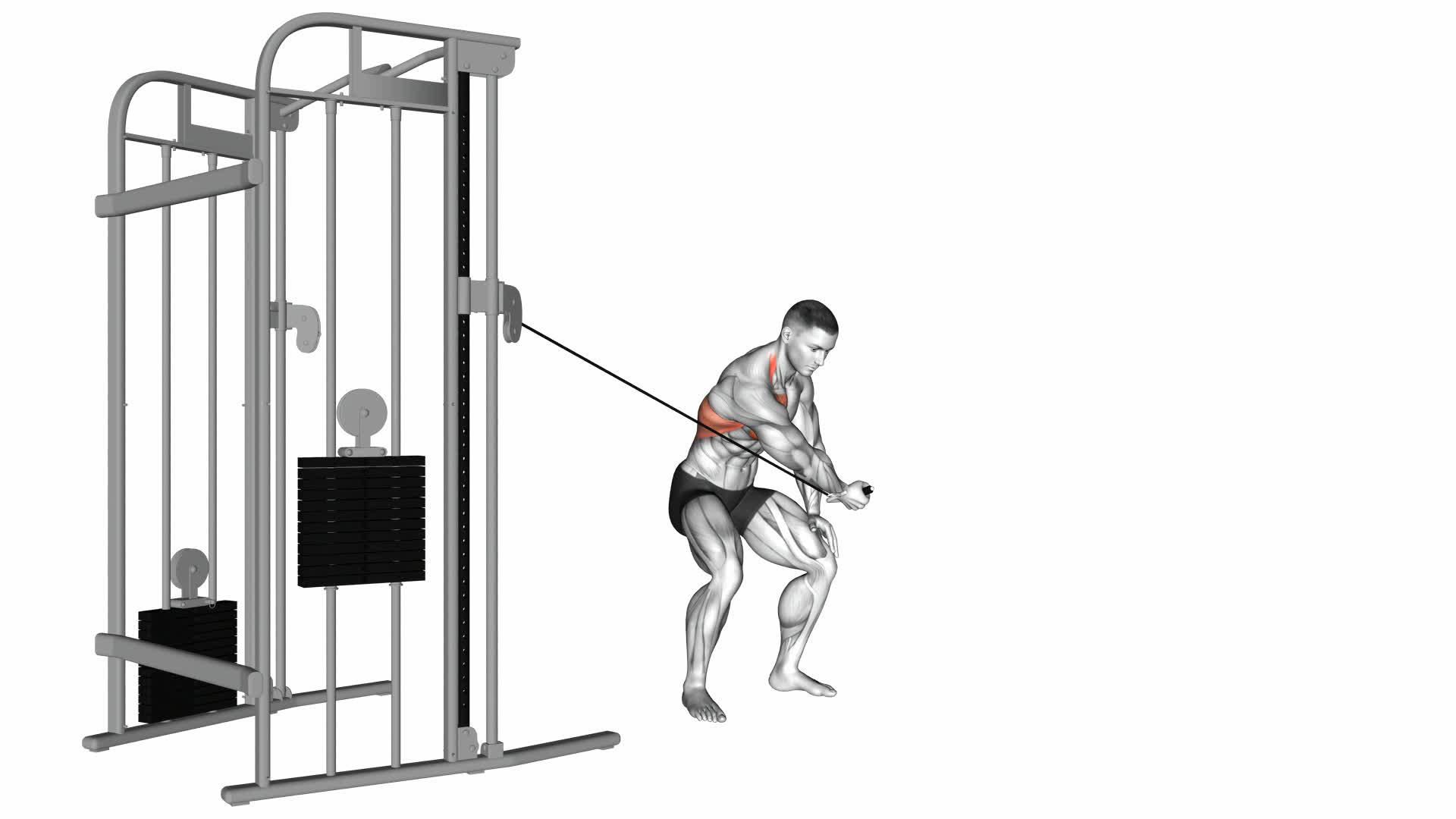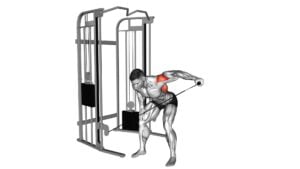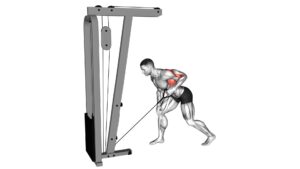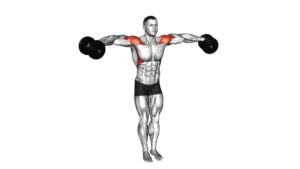Cable One Arm Lateral Bent Over – Video Exercise Guide & Tips

Incorporate Cable One Arm Lateral Bent Over into your workout routine for targeted shoulder and back strength. This video exercise guide provides tips and proper technique for maximizing your results.
Watch This Exercise Video
Avoid common mistakes and discover variations to challenge yourself further. With the help of this informative guide, you'll be on your way to achieving your fitness goals.
So grab a cable and get ready to strengthen and tone your upper body with this effective exercise.
Key Takeaways
- Cable One Arm Lateral Bent Over targets and strengthens the lateral deltoid muscles.
- Proper form and technique are crucial to maintain shoulder stability and prevent injuries.
- Engaging core muscles and maintaining proper posture enhances the effectiveness of the exercise.
- Variations and progressions can be incorporated to increase the challenge and prevent plateau.
Benefits of Cable One Arm Lateral Bent Over
The first benefit of Cable One Arm Lateral Bent Over is that it targets and strengthens the lateral deltoid muscles. This exercise specifically focuses on the side muscles of the shoulder, helping to develop definition and strength in that area. By isolating and engaging the lateral deltoids, you can enhance your overall shoulder stability and improve upper body strength.
Additionally, Cable One Arm Lateral Bent Over is a highly effective exercise for improving posture. It helps to counteract the forward rounding of the shoulders that's common in our daily activities, such as prolonged sitting and computer work. This exercise promotes proper alignment and encourages a strong, upright posture.
Incorporating Cable One Arm Lateral Bent Over into your workout routine can also assist in enhancing shoulder mobility and flexibility. By engaging in a full range of motion during the exercise, you can improve the overall flexibility of your shoulders. This can be particularly beneficial for athletes or individuals involved in activities that require a wide range of shoulder movement.
With its numerous benefits, Cable One Arm Lateral Bent Over is a valuable exercise to incorporate into your fitness regimen.
Now that you understand the benefits of Cable One Arm Lateral Bent Over, let's move on to the equipment and setup for this exercise.
Equipment and Setup for Cable One Arm Lateral Bent Over
To set up for the Cable One Arm Lateral Bent Over exercise, start by adjusting the cable height to a level that allows your arm to comfortably extend laterally.
Position yourself on a bench with your chest and torso bent over at a 45-degree angle.
Grip the handle firmly with your palm facing down, ensuring a secure and stable hold.
These three points are crucial for a proper equipment setup to maximize the effectiveness and safety of the exercise.
Optimal Cable Height
Achieving optimal cable height plays a crucial role in maximizing the effectiveness of your cable one arm lateral bent over exercise. Here are four reasons why finding the right cable height is essential for your workout:
- Improved targeting: Adjusting the cable to the optimal height ensures that you're targeting the intended muscles, such as the deltoids and trapezius, effectively.
- Reduced strain: Setting the cable at the right height allows for a natural range of motion, minimizing the risk of strain or injury to your shoulders and back.
- Increased resistance: Finding the optimal cable weight ensures that you can challenge yourself appropriately, promoting muscle growth and strength gains.
- Variation possibilities: Adjusting the cable height enables you to perform alternative exercises, such as cable rear delt flyes or cable bent-over rows, targeting different muscle groups for a well-rounded workout.
Proper Bench Positioning
To properly position yourself on the bench for the cable one arm lateral bent over exercise, ensure that your equipment and setup are suitable.
Start by choosing a bench that's stable and secure. Make sure it can support your weight and provide a comfortable surface to lean on.
Position the bench parallel to the cable machine, allowing enough space for your arm to extend fully during the exercise.
Sit on the bench with your feet flat on the ground and your back straight. This will help maintain proper shoulder stability throughout the movement.
Once you have positioned yourself correctly on the bench, you can proceed to grip the handle and prepare for the exercise.
Gripping the Handle
Choose a suitable handle for the cable one arm lateral bent over exercise, ensuring it provides a secure grip and allows for a full range of motion. The handle should be comfortable to hold and easy to grip, as grip strength is crucial for maintaining stability and control during the exercise.
When gripping the handle, make sure your hand placement is firm and secure. Here are four tips to help you improve your grip strength and maximize your performance:
- Use a handle with textured or rubberized surfaces to enhance grip.
- Place your hand firmly around the handle, ensuring all fingers are engaged.
- Avoid gripping the handle too tightly, as this can lead to fatigue and muscle strain.
- Experiment with different hand positions and angles to find the most comfortable and effective grip for you.
Proper Form and Technique for Cable One Arm Lateral Bent Over
To perform the Cable One Arm Lateral Bent Over exercise with proper form and technique, it's important to focus on maintaining shoulder stability throughout the movement.
Keeping your core engaged and spine neutral, hinge at the hips while keeping your back straight.
Shoulder Stability During Exercise
You can improve your shoulder stability during the Cable One Arm Lateral Bent Over exercise by focusing on proper form and technique. Here are four important tips to help you maintain shoulder stability throughout the exercise:
- Engage your core: By engaging your core muscles, you create a solid foundation for your shoulders, allowing them to remain stable and supported during the exercise.
- Keep your shoulder blades retracted: Pull your shoulder blades back and down throughout the movement. This helps to stabilize your shoulders and prevent any unnecessary stress or strain.
- Control the weight: Avoid using excessive weight that can compromise your form and stability. Start with a lighter weight and gradually increase as you become more comfortable and confident.
- Maintain proper posture: Stand tall with your chest lifted and your back straight. This helps to align your body and distribute the load evenly, reducing the risk of shoulder injuries.
Benefits of Proper Technique
To maximize the benefits of the Cable One Arm Lateral Bent Over exercise, it's important to maintain proper form and technique. Proper form not only ensures that you're targeting the intended muscles effectively, but it also plays a crucial role in injury prevention.
When you perform the exercise with proper form, you reduce the risk of straining or injuring your back, shoulders, or arms. By keeping your back straight, hinging at the hips, and engaging your core, you ensure that the movement is controlled and stable.
This not only helps to activate the targeted muscles more efficiently but also reduces the likelihood of muscle imbalances or compensations. So, remember to prioritize proper form to reap the full benefits of the Cable One Arm Lateral Bent Over exercise while minimizing the risk of injuries.
Common Mistakes to Avoid During Cable One Arm Lateral Bent Over
During the Cable One Arm Lateral Bent Over exercise, it's important to be mindful of the common mistakes that can hinder your progress and potentially lead to injury. To ensure proper shoulder stability during this exercise, here are four mistakes you should avoid:
- Rounding your shoulders: Keep your shoulders back and down throughout the movement. Rounding your shoulders can place excessive stress on your joints and compromise your form.
- Using too much weight: It's crucial to choose a weight that you can control throughout the exercise. Using too much weight can lead to poor form, reducing the effectiveness of the exercise and increasing the risk of injury.
- Arching your back: Maintain a neutral spine position by engaging your core and avoiding excessive arching of your back. Arching your back puts unnecessary strain on your lower back and takes away from the targeted muscles.
- Allowing your elbow to flare out: Keep your elbow close to your body and avoid allowing it to flare outwards. This ensures proper engagement of the lateral deltoid and reduces the risk of shoulder impingement.
Variations and Progressions of Cable One Arm Lateral Bent Over
To further challenge yourself and continue progressing with the Cable One Arm Lateral Bent Over exercise, you can explore various variations and progressions.
These variations allow you to target different muscle groups and add variety to your workout routine.
One variation is the Cable One Arm Lateral Bent Over with a Twist. Instead of simply raising your arm laterally, you can add a twist at the end of the movement to engage your obliques and increase the challenge.
Another variation is the Cable One Arm Lateral Bent Over with a Resistance Band. By attaching a resistance band to the cable handle, you can add extra resistance and intensity to the exercise. This is especially beneficial for those who've mastered the basic form and want to further challenge themselves.
Progressions of the Cable One Arm Lateral Bent Over exercise include increasing the weight, number of repetitions, or sets. You can also try performing the exercise on an unstable surface, such as a Bosu ball, to engage your core muscles even more.
Remember to always maintain proper form and listen to your body to avoid injury.
Tips for Incorporating Cable One Arm Lateral Bent Over Into Your Workout Routine
To incorporate Cable One Arm Lateral Bent Over into your workout routine, try adding it as a challenging compound exercise for your upper body. This exercise targets your shoulders, specifically the lateral deltoids, as well as your back muscles. Here are some tips to help you effectively incorporate this exercise into your routine:
- Start with lighter weights: Since this exercise requires you to maintain proper form and balance, it's important to start with lighter weights and gradually increase the resistance as you become more comfortable with the movement.
- Focus on proper form: Keep your back straight and hinge forward at your hips while maintaining a slight bend in your knees. Engage your core and avoid rounding your shoulders. This will ensure that you're targeting the intended muscles and reducing the risk of injury.
- Use alternative equipment: If you don't have access to a cable machine, you can still perform a similar movement using dumbbells or resistance bands. This will allow you to continue working your shoulders and back muscles effectively.
- Include variations: To keep your routine challenging and prevent plateau, try incorporating variations of the Cable One Arm Lateral Bent Over exercise. For example, you can perform the exercise while standing or use different grip positions to target different muscles.
Frequently Asked Questions
How Many Sets and Repetitions Should I Do for the Cable One Arm Lateral Bent Over Exercise?
To determine the number of sets and repetitions for the cable one arm lateral bent over exercise, you should consider your fitness level and goals. As a general guideline, beginners can start with 2-3 sets of 8-12 repetitions per arm.
This exercise helps to strengthen and tone your lateral deltoids, improving shoulder stability and posture. Incorporating the cable one arm lateral bent over exercise into your routine can provide a challenging and effective upper body workout.
Can I Use Dumbbells Instead of a Cable Machine for the Cable One Arm Lateral Bent Over Exercise?
Yes, you can use dumbbells as an alternative to the cable machine for the one arm lateral bent over exercise. This modification allows you to work the same muscles effectively.
To perform the exercise with dumbbells, simply hold one dumbbell in your hand and lean forward, keeping your back straight. Lift the dumbbell out to the side, focusing on engaging your shoulder muscles.
Repeat for the desired number of repetitions and sets.
Is It Normal to Feel Some Discomfort in My Lower Back During the Cable One Arm Lateral Bent Over Exercise?
Feeling some discomfort in your lower back during the cable one arm lateral bent over exercise isn't uncommon. It could be due to improper form or lack of core stability.
Make sure you maintain a neutral spine and engage your core throughout the movement.
If the discomfort persists, consider reducing the weight or consulting a fitness professional for guidance.
Proper form and technique are crucial to prevent lower back pain and ensure a safe and effective workout.
Can I Perform the Cable One Arm Lateral Bent Over Exercise Standing up Instead of Bent Over?
Yes, you can perform the cable one arm lateral bent over exercise in a standing position.
However, it's important to note that the bent over position helps to engage and target your back muscles more effectively.
If you find discomfort or are unable to perform the exercise in a bent over position, there are alternative exercises that target the same muscles, such as lateral raises with dumbbells or resistance bands.
How Long Should I Rest Between Sets for the Cable One Arm Lateral Bent Over Exercise?
To ensure optimal results and reduce the risk of injury, it's essential to rest between sets for the cable one arm lateral bent over exercise.
The rest duration may vary depending on your fitness level and goals. A general guideline is to rest for about 30-90 seconds between sets.
However, listen to your body and adjust the rest time accordingly.
Remember to maintain proper form throughout the exercise to target the intended muscles effectively.
Conclusion
In conclusion, the Cable One Arm Lateral Bent Over exercise is a highly effective way to target and strengthen your lateral deltoids.
By using a cable machine, you can add resistance and control to the movement, resulting in increased muscle activation.
Remember to maintain proper form and avoid common mistakes to maximize the benefits of this exercise.
Incorporating Cable One Arm Lateral Bent Over into your workout routine can help you achieve a well-rounded and balanced shoulder workout.

Author
Years ago, the spark of my life’s passion ignited in my mind the moment I stepped into the local gym for the first time. The inaugural bead of perspiration, the initial endeavor, the very first surge of endorphins, and a sense of pride that washed over me post-workout marked the beginning of my deep-seated interest in strength sports, fitness, and sports nutrition. This very curiosity blossomed rapidly into a profound fascination, propelling me to earn a Master’s degree in Physical Education from the Academy of Physical Education in Krakow, followed by a Sports Manager diploma from the Jagiellonian University. My journey of growth led me to gain more specialized qualifications, such as being a certified personal trainer with a focus on sports dietetics, a lifeguard, and an instructor for wellness and corrective gymnastics. Theoretical knowledge paired seamlessly with practical experience, reinforcing my belief that the transformation of individuals under my guidance was also a reflection of my personal growth. This belief holds true even today. Each day, I strive to push the boundaries and explore new realms. These realms gently elevate me to greater heights. The unique combination of passion for my field and the continuous quest for growth fuels my drive to break new ground.







